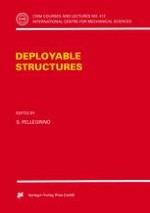2001 | OriginalPaper | Buchkapitel
Deployable Structures in Nature
verfasst von : Julian F. V. Vincent
Erschienen in: Deployable Structures
Verlag: Springer Vienna
Enthalten in: Professional Book Archive
Aktivieren Sie unsere intelligente Suche, um passende Fachinhalte oder Patente zu finden.
Wählen Sie Textabschnitte aus um mit Künstlicher Intelligenz passenden Patente zu finden. powered by
Markieren Sie Textabschnitte, um KI-gestützt weitere passende Inhalte zu finden. powered by
One could almost redefine biology as the natural history of deployable structures. An organism is successful partly because it uses the minimum amount of material to make its structure and partly because it can then optimise its use of that material so that it can influence as much of its local environment as possible. The more of its environment it can control and utilise for energy gain (“feeding”) per unit energy expended in growing and moving, the more successful the organism will be since it will have more energy available for reproduction, the ultimate criterion of success. One might even invent a parameter of success based on effectiveness of deployment. Perhaps this would be the least volume fraction of its environment which an organism can occupy. One would then equate the “addressable volume” (i.e. the volume you can entrain by waving your arms and legs around to their maximum extent) with the volume which your body occupies. A similar sort of parameter has been proposed for animals which feed by filtering particles out of the water (e.g. barnacles, sea anemones) or the air (e.g. a spider with its web). The longer, thinner and more mobile the limbs the greater the relative addressable volume but the greater the likelihood of the structure breaking.
